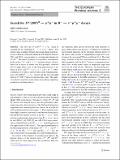Search for 𝐷∗(2007)0→ 𝜇+𝜇− in 𝐵− → 𝜋−𝜇+𝜇− decays
Author(s)
Aaij, R.; Abdelmotteleb, A. S. W.; Beteta, C. A.; Abudinén, F.; Ackernley, T.; Adeva, B.; Adinolfi, M.; Adlarson, P.; Afsharnia, H.; Agapopoulou, C.; Aidala, C. A.; Ajaltouni, Z.; Akar, S.; Akiba, K.; Albicocco, P.; Albrecht, J.; Alessio, F.; Alexander, M.; Albero, A. A.; Aliouche, Z.; ... Show more Show less
Download10052_2023_Article_11759.pdf (1.903Mb)
Publisher with Creative Commons License
Publisher with Creative Commons License
Creative Commons Attribution
Terms of use
Metadata
Show full item recordAbstract
Abstract
The very rare
$${{D} ^*} (2007)^0\!\rightarrow {\mu ^+\mu ^-} $$
D
∗
(
2007
)
0
→
μ
+
μ
-
decay is searched for by analysing
$${{{B} ^-}} \!\rightarrow {{\pi } ^-} {\mu ^+\mu ^-} $$
B
-
→
π
-
μ
+
μ
-
decays. The analysis uses a sample of beauty mesons produced in proton–proton collisions collected with the LHCb detector between 2011 and 2018, corresponding to an integrated luminosity of 9
$$\text {\,fb} ^{-1}$$
\,fb
-
1
. The signal signature corresponds to simultaneous peaks in the
$${\mu ^+\mu ^-} $$
μ
+
μ
-
and
$${{\pi } ^-} {\mu ^+\mu ^-} $$
π
-
μ
+
μ
-
invariant masses. No evidence for an excess of events over background is observed and an upper limit is set on the branching fraction of the decay at
$$\mathcal{B}({{D} ^*} (2007)^0\!\rightarrow {\mu ^+\mu ^-} ) < 2.6\times 10^{-8}$$
B
(
D
∗
(
2007
)
0
→
μ
+
μ
-
)
<
2.6
×
10
-
8
at
$$90\%$$
90
%
confidence level. This is the first limit on the branching fraction of
$${{D} ^*} (2007)^0\!\rightarrow {\mu ^+\mu ^-} $$
D
∗
(
2007
)
0
→
μ
+
μ
-
decays and the most stringent limit on
$${{D} ^*} (2007)^0$$
D
∗
(
2007
)
0
decays to leptonic final states. The analysis is the first search for a rare charm-meson decay exploiting production via beauty decays.
Date issued
2023-07-26Department
Massachusetts Institute of Technology. Department of PhysicsPublisher
Springer Berlin Heidelberg
Citation
The European Physical Journal C. 2023 Jul 26;83(7):666
Version: Final published version